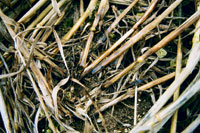New tool will aid eyespot treatment decisions in wheat

The problem with eyespot is that there is no clear relationship between disease levels and yield loss, which can be up to 25%.
This leaves growers with crops in high risk eyespot situations struggling to assess whether preventative spraying would be cost-effective, explains Fiona Burnett of the Scottish Agricultural College.
“We used to think eyespot was site-specific and spraying was worthwhile in most second and third wheats in the rotation. But then, in the 1990s, we realised first wheats after a one-year break were as prone to infection as second and subsequent wheats, so risk assessment was modified.
HGCA Perspective
• Define the risks relating to yield loss from eyespot
• Better understand how changing management strategies influence current distribution of W and R types
• Update the existing eyespot risk model to encompass developments in varietal resistance and recent fungicide advances
• Evaluate likely spread and incidence under climate change scenarios
Interim report available on the HGCA website:
HGCA has funded just over a third of the total cost of £552,000 with the remainder being in-kind donations of trials data from agrochemical companies.
HGCA Perspective
• Define the risks relating to yield loss from eyespot
• Better understand how changing management strategies influence current distribution of W and R types
• Update the existing eyespot risk model to encompass developments in varietal resistance and recent fungicide advances
• Evaluate likely spread and incidence under climate change scenarios
Interim report available on the HGCA website:
HGCA has funded just over a third of the total cost of £552,000 with the remainder being in-kind donations of trials data from agrochemical companies.
“Since then, other risk factors have been identified and accounted for, but the disease is still catching growers out. The problem is that there is a tenuous relationship between eyespot levels and yield loss. We need to refine the risk criteria.”
She is co-ordinating a project to do just that. The result so far is a finely-tuned risk assessment model, incorporating all the factors known to influence eyespot, such as soil type, variety, cultivation method, sowing date and weather. Included to clarify the economics of treatment are the costs of the three common fungicides with eyespot activity – cyprodinil (Unix), prothioconazole (Proline) and boscalid and epoxiconazole (Tracker).
This time next year, growers should have access to the improved decision support system, probably via the web or as a print out, she hopes. As in the existing model, each contributory factor will be weighted and an overall score for risk given. But when combined with new yield loss data, it should be simpler and more accurate to optimise product choice and rate.
“If we find that treatment decisions become more accurate as the season progresses, and this could be utilised through improved spray application technologies to allow later, but more accurate treatments for eyespot, the risk model could be modified to include treatment options at appropriate timings.”
| Crops’ perspective It’s apt that a model borrowed from medical science is aiding wheat disease control. In providing growers with a more accurate method of judging the likely yield loss from eyespot, this project should reduce field losses and rationalise fungicide use, which is good news for the environment, too. |
|---|
She is also looking at how weather can be conducive to eyespot infection and development, and how climate change may affect its incidence. However, she believes agronomic factors will have more of an impact on risk assessment than rainfall and temperature.
“It seems the amount of rainfall between March and May is critical to eyespot development, regardless of where in the country you are farming. With last year’s dry spring, we saw high levels of eyespot over winter yet there was little yield loss.”
One obvious way to minimise disease impact is to grow a tolerant variety. There are several with some inherent resistance of the Pch1 type on the current Recommended List, for example Grafton, Battalion, Scout and Marksman. Dr Burnett sees their contribution to the model on another level.
“If the risk is high before sowing, you could choose a variety offering some resistance, then review the risk in the spring to decide on spraying,” she suggests.
Similarly, there could be another level dealing with the interaction between the W and R types of the pathogen. The W type is faster developing, more dominant and is linked more closely with lodging, she believes.
| Study summary Project no 3362: Forecasting eyespot development and yield losses in winter wheat; SAC, The Arable Group, University of EdinburghBritish Wheat Breeders, Bayer CropScience, Syngenta, BASF, University of Nottingham, Harper Adams University College; from September 2007 to April 2011. |
|---|

